Franchising, retail, business
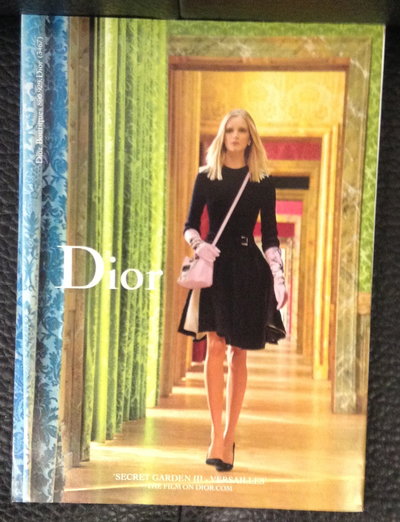
05/08/2014
Ralph Lauren, Chanel and Gucci were among the luxury fashion marketers to share current collections with the cross-generational readers of Vogue’s August issue.
The 222-page “Age” issue profiles women of different ages who are physically fit, embracing online dating and torch signing. Marketers can benefit from being visible in this type of themed issue because it will attract readers from multiple demographics, all of which have an interest in Vogue’s fashion coverage.
“Age is potentially a big problem for Vogue,” said Al Ries, founder and chairman of Ries & Ries, a Roswell, GA-based marketing strategy consultancy. “The younger generation is not into fashion the way the older generation was.
“A significant number of young women, for example, have tattoos, not exactly a fashion statement,” he said. “So Vogue is probably interested in broadening the magazine’s appeal to include younger people.
“On the other hand, it can’t afford to offend its older audience either. So they designed the “Age issue” to appeal to a wide range of women.”
Mr. Ries is not affiliated with Vogue, but agreed to comment as an industry expert.
Condé Nast’s Vogue, which did not respond by press deadline, has a total average circulation of 1,222,323 readers with a median household income of $69,447.
Timeless
U.S. fashion label Ralph Lauren opened the August issue of Vogue with a tri-fold advertisement for its latest rendition of the Ricky handbag, the ID chain bag.
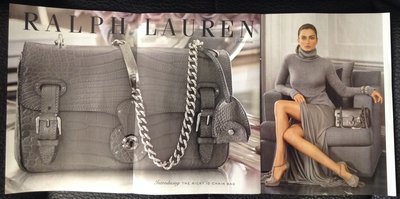
Chanel followed with its fall/winter campaign that shows models Binx Walton and Cara Delevingne mid-sprint wearing tweed suits, matching sneakers and carrying quilted clutches
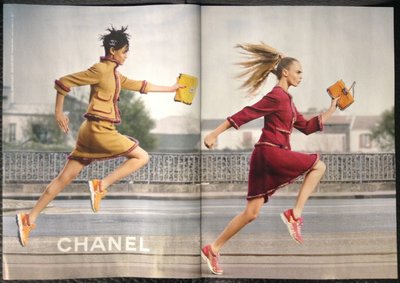
Also seen in the front of the book was Gucci’s ongoing effort for fall/winter 2014-2015 and Dolce & Gabbana’s royal family-themed campaign set in an enchanted forest.
The front of the book was continued by ads from Fendi, Céline, Estée Lauder and two full-page spreads from Prada. Versace, Lancôme, Marc Jacobs, Bottega Veneta, Burberry and two full-page spread by Prada-owned Miu Miu were also seen.
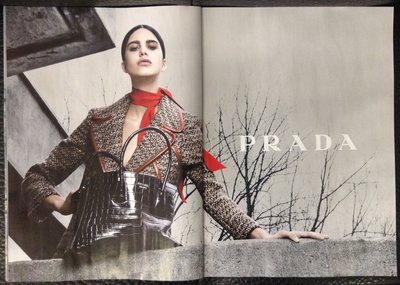 Gucci broke up the fashion efforts with a campaign for its latest fragrance Premiere. The ad features actress Blake Lively, who is also on the cover of the August issue.
Gucci broke up the fashion efforts with a campaign for its latest fragrance Premiere. The ad features actress Blake Lively, who is also on the cover of the August issue.
In the pages after this point, Saint Laurent Paris, Michael Kors, La Perla, a second Lancôme effort and Tiffany & Co. were seen.
Opposite the first section of the table of contents Estée Lauder returned with a spot for its Pure Color Envy lipstick. Chanel’s Chance Eau Tendre was seen across from the continuation and Salvatore Ferragamo closed out the section with a handbag and ready-to-wear campaign.
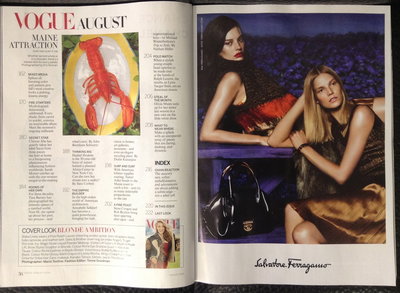 After the table of contents, and within the content pages, campaign efforts by Louis Vuitton, Van Cleef & Arpels, Jimmy Choo, Balmain, Lexus and Kuwaiti fragrance house Ne’emah were seen.
After the table of contents, and within the content pages, campaign efforts by Louis Vuitton, Van Cleef & Arpels, Jimmy Choo, Balmain, Lexus and Kuwaiti fragrance house Ne’emah were seen.
The issue concluded with an outside back cover effort by Dior for its “Secret Garden III – Versailles” campaign.
Content in “The Age” issue includes a profile of Ms. Lively that looks at her career’s start on the CW’s “Gossip Girl” to her entry into the online lifestyle site, Preserve, a listorial of famous redheads and the fashion coverage of “bold colors, rock-star boots and playful prints.”
Ageless
To maintain audiences, and relevancy, publications vary content to attract readers from different age groups.
For instance, luxury marketers such as Prada and Christian Dior jockeyed for attention in the July issue of Condé Nast’s Vogue that featured actress Lupita Nyong’o on the cover.
The 152-page July issue’s main feature was “Women to Watch,” giving marketers even more reason to want to be seen side-by-side with the latest “it girls, newsmakers, rule-breakers and scene-stealers” as the tagline suggests. With summer months’ advertising space lower than during other prime months such as September or December, being seen in a listorial profile issue will help brands make an impression (see story).
Also, Christian Dior and Gucci were among the marketers using Vanity Fair’s “Hollywood’s Next Wave” special issue to appeal to a new generation of consumers.
The 116-page July issue included Vanity Fair’s coverage of young Hollywood starlets that are up-and-coming in the industry. With profiles on budding talent, the likelihood of the magazine appealing to a younger audience is higher as fans of the actors are likely to purchase the July edition of the imprint, which will also boost exposure for the featured marketers among this aspirational demographic (see story).
Although the advertising partners support the issue’s content and are relevant to the reader’s lifestyle, ads do not need to be perfectly aligned.
“The best advertising doesn’t try to fit in with the theme of any issue,” Mr. Ries said. “If an advertiser tries to that, it destroys the continuity of an advertising campaign.
“The best advertising is built around a single idea, both visually and verbally,” he said. “And ignores whatever the theme of a particular issue is.”
Fonte: luxurydaily.com